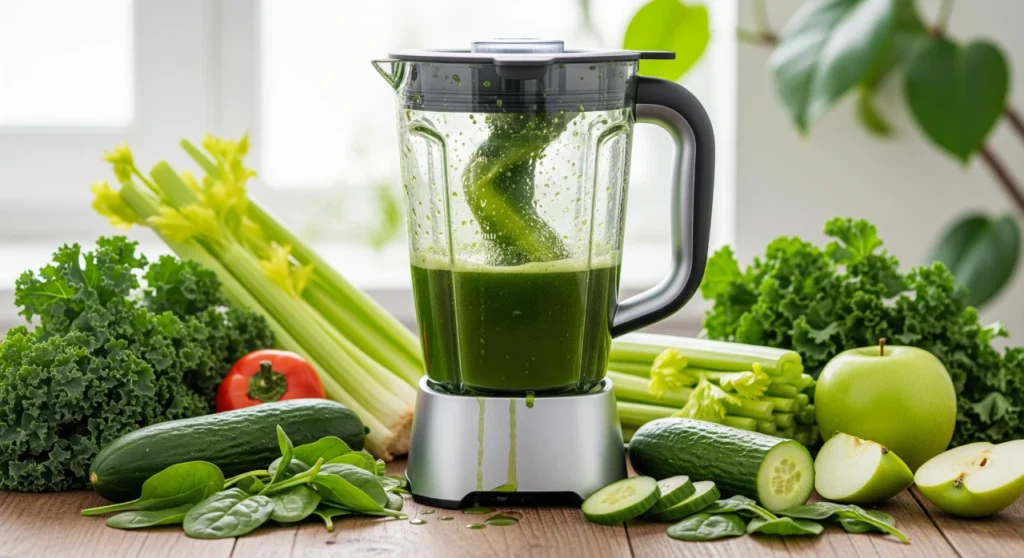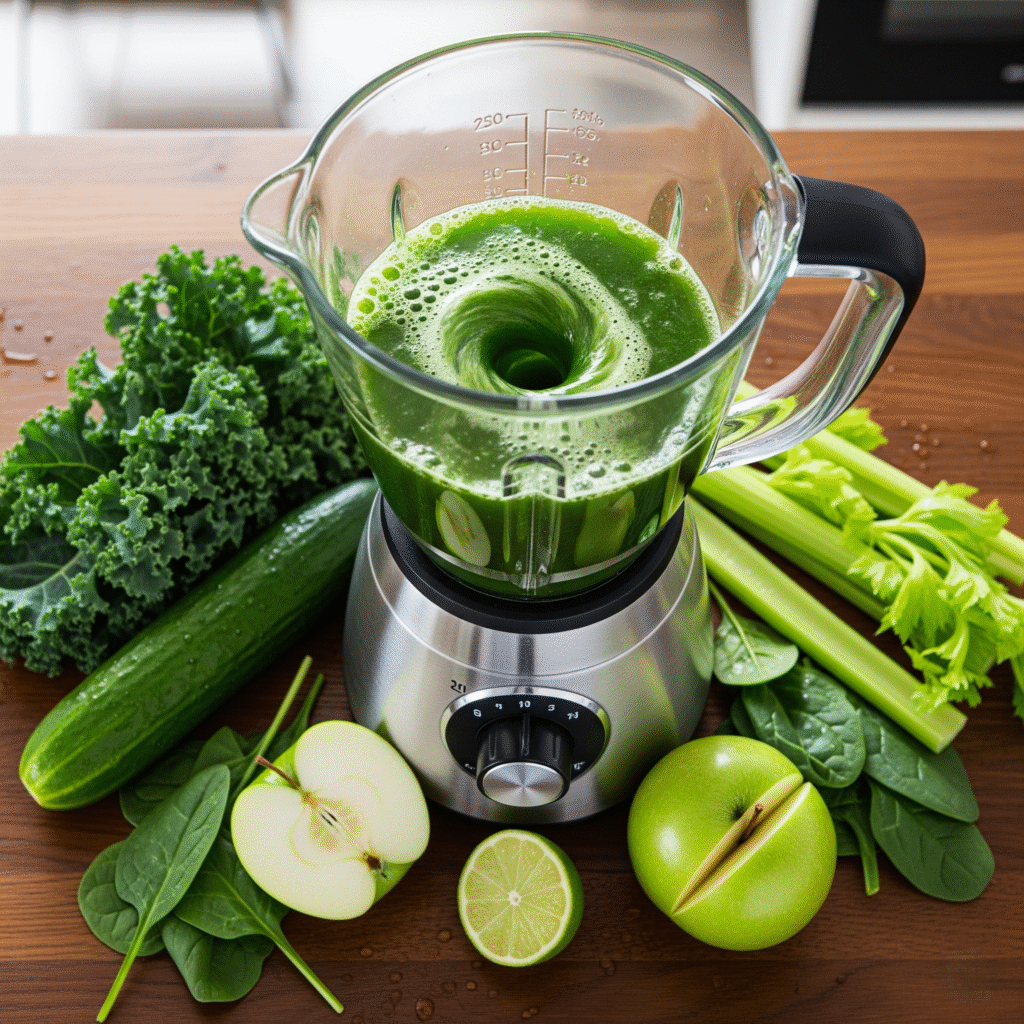
Introduction to Juicing and the Importance of Choosing the Right Blender
Juicing vegetables has gained significant popularity as individuals increasingly recognize its myriad health benefits. Extracting juice from fresh vegetables allows consumers to obtain essential vitamins, minerals, and antioxidants in a concentrated form. This practice not only supports a healthy diet but also enhances overall well-being, making it easier to include vital nutrients in daily meals. Included in this nutritious trend is the use of blenders specifically designed for juicing, which play a crucial role in the quality of the juice produced.
Choosing the right blender for juicing vegetables is paramount for maximizing juice extraction and ensuring a delicious, nutrient-rich output. A powerful blender can effectively break down tough vegetables, extracting more juice and fiber while preserving vitamins and enzymes. The blade design is another essential consideration; high-quality, sharp blades will facilitate the efficient chopping and pureeing of vegetables, leading to a smoother juice consistency. Additionally, certain blenders are equipped with features that enhance their juicing capabilities, such as variable speed settings and built-in strainers.
Capacity is also a vital factor to consider when selecting a blender for juicing. Depending on individual preferences and household needs, a larger capacity may be advantageous for those who plan on making juice in bulk or for multiple servings at once. Conversely, individuals with limited storage space may opt for a more compact model. Furthermore, ease of cleaning and the materials used in construction can greatly impact long-term satisfaction with the product.
Ultimately, investing time and research into identifying the right blender for juicing vegetables will significantly enhance the juicing experience. Not only will it ensure optimal extraction of nutrients, but a quality blender can also save time and make the process more enjoyable. Understanding the importance of these various factors can empower consumers to make informed choices that align with their health goals.
Top Features to Look for in a Blender for Juicing Vegetables

When selecting a blender specifically for juicing vegetables, it is crucial to consider several key features that can significantly impact performance and usability. These aspects include motor strength, blade types, ease of cleaning, noise levels, and versatility.
First and foremost, motor strength plays a vital role in determining how effectively a blender can handle tough vegetables. A higher wattage, usually ranging from 600 to 1500 watts, translates to better blending performance, allowing for smoother and finer juice extraction. A well-powered motor ensures the blender can easily break down fibrous vegetable materials, providing a more nutritious output.
Next, the type of blades is equally important. Blenders equipped with sharp, durable stainless steel blades are generally more effective at chopping and pulverizing vegetables. Some blenders come with multiple blade configurations, allowing users to switch between different setups for optimal juicing results. Additionally, certain models may offer specialized blades that enhance performance, especially when dealing with leafy greens or tougher vegetable skins.
Ease of cleaning is another feature that should not be overlooked. A blender designed to be disassembled easily or that is dishwasher safe simplifies the post-juicing cleanup process. Certain blenders come with self-cleaning functions, allowing you to maintain hygiene without the hassle. The materials used in the blender also play a part, as BPA-free plastics are preferred for their safety and ease of maintenance.
Another consideration is noise levels during operation. Noise can be a significant factor for many users, especially in quieter settings. Investing in a blender with noise-reduced technology can enhance the overall juicing experience while also making it more pleasant for others in the vicinity.
Finally, versatility is an advantageous feature to look for. A blender that can effectively juice vegetables while also handling fruits, soups, and other food items adds value to your purchase. This multipurpose functionality ensures that the blender can serve various culinary needs beyond juicing.
Review of the Best Blenders for Juicing Vegetables on Amazon
When it comes to juicing vegetables, having the right blender can greatly enhance the quality of the juice produced. Here, we present a selection of the best blenders available on Amazon specifically dedicated to juicing, featuring key specifications, pros and cons, and customer feedback to simplify your purchasing decision.
One outstanding option is the Vitamix 5200. Known for its powerful motor and robust design, this blender can effortlessly liquefy fibrous vegetables. Users praise its adaptability for both hot and cold ingredients, making it a versatile choice for various recipes. The Vitamix 5200 typically retails for around $449.99. However, some customers have noted the high price point as a disadvantage.
Another commendable product is the Ninja Mega Kitchen System, which integrates a high-performance blender with a food processor. This unit is ideal for creating vegetable juices with a smooth consistency. Priced around $199.99, it offers exceptional value, although a few users have reported its noise level as a drawback during operation.
For those looking for a budget-friendly choice, the Hamilton Beach Power Elite Blender is a solid option, available for approximately $34.99. This blender is user-friendly and provides satisfactory results for juicing softer vegetables. Nevertheless, some customers have expressed concerns regarding its durability compared to higher-end models.
Finally, the Breville Super Q stands out for its innovative features, including a personal blending vessel. Priced at about $399.95, it garners attention for its ability to handle tough vegetables seamlessly. However, some customers have mentioned that it may require some practice to master its settings.
In essence, the individual attributes of each blender make them suitable for various needs and preferences, providing everyone from budget-conscious buyers to serious chefs a viable option for juicing vegetables effectively.
Tips for Getting the Most Out of Your Blender for Juicing
To truly maximize the effectiveness of your blender for juicing vegetables, it is essential to adopt certain best practices that enhance the overall experience and result. Preparing your vegetables properly is the first step in this process. Start by washing all vegetables thoroughly to remove any pesticides or dirt. Cutting them into smaller pieces not only reduces blending time but also helps in achieving a finer texture, leading to a smoother juice. Leafy greens like spinach or kale can be torn into smaller fragments, while harder vegetables, such as carrots or beets, should be chopped into manageable chunks.
When it comes to blending techniques, it is highly recommended to layer your ingredients properly. Start with the soft vegetables or fruits on the bottom, followed by harder ones, and finish with leafy greens on top. This order helps create a vortex that pulls the ingredients down toward the blades more effectively, ensuring everything is blended evenly. Additionally, consider adding a small amount of liquid, such as water or coconut water, to facilitate movement and reduce strain on the blender motor. Pulse blending initially can also help break down tougher vegetables before setting the blender to a higher speed.
Maintenance is another crucial aspect of optimizing your blender’s performance. After each use, promptly clean the blender to prevent residue from hardening. Most blenders can be cleaned easily by filling them with warm water and a drop of dish soap, then blending for a few seconds. Regularly check the blades for dullness and replace them if necessary. Should you encounter any common juicing issues, such as separation or insufficient blending, adjusting the speed settings or adding more liquid can resolve these problems. By following these tips, you can ensure your juicing experience is both productive and satisfying.